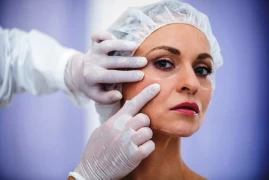
Revision Rhinoplasty
- Revision Rhinoplasty
- What is Revision Rhinoplasty?
- Why is Revision Rhinoplasty Needed?
- What are the Reasons for Revision Rhinoplasty?
- How is Revision Rhinoplasty Decided?
- When Is Revision Rhinoplasty Decided?
- What Is Used To Perform Revision Rhinoplasty?
What is Revision Rhinoplasty?
Revision rhinoplasty is an aesthetic nose surgery that is performed again as a result of not getting the desired result from the previous nose surgery or when the surgical procedure creates a different complication in the nose. The terms secondary rhinoplasty or correction surgery are also used instead of revision rhinoplasty. According to some terminologies, the second operation performed by the surgeon to correct the negative results of his own operation is called revision rhinoplasty, while the correction operation performed by other surgeons is called secondary rhinoplasty.
Why is Revision Rhinoplasty Needed?
It is a delicate process like aesthetic nose surgery. After these surgeries, there may be a need for re-correction at a rate of 8-15%. This process, which requires patients to be operated again, can actually be caused by many different factors. It should be noted that at this point, the experience of the surgeon, who has performed rhinoplasty, has an undeniable effect in this field. First of all, it is an important factor here that the physician cannot fully understand what the patient wants in the first interview. It is necessary to make a planning that can satisfy both the physician and the patient in terms of functionality and aesthetics. Of course, the physician should be able to explain to the patient well the reasonable requests that can be and the requests and reasons that cannot be. The most appropriate technique and correction should be planned for his anatomy and skin structure.
What are the Reasons for Revision Rhinoplasty?
The occurrence of aesthetic and functional complications after the first operation, called primary rhinoplasty, essentially constitutes the rationale for revision rhinoplasty. In general, the following causes after rhinoplasty surgery are the factors that play a role in the decision for revision rhinoplasty;
- Asymmetry in the nostrils
- Elevation of the nasal arch
- Irregularity on the back of the nose
- Collapse in the side walls of the nose
- Nose slip formation
- Development of excessive scar tissue inside or outside the nose
- Formation of a drooping or excessively shortened or upturned (pig nose) appearance
- Shortness of breath
How is Revision Rhinoplasty Decided?
In fact, the quality and care of the first operation closely affects the revision surgery. Whether it is at least a minor procedure, which we call a 'minor revision', or a comprehensive surgery where major problems will have to be solved, also depends on the previous surgery and its outcome. Inflammation or bleeding that may develop after surgery may also lead to deterioration of the shape of the nose and the necessity of surgery in the long term.
When Is Revision Rhinoplasty Decided?
As a timing, it would be a more accurate approach to plan revision rhinoplasty surgery with the control performed 6 months after the earliest rhinoplasty surgery and after the nose is fully seated. If the decision is made in the early period before the edema has passed, additional problems that may become visible after edema may remain hidden. Therefore, an incomplete correction will be made with revision surgery to be performed in the early returner. It is extremely important not to act hastily and prematurely.
What Is Used To Perform Revision Rhinoplasty?
In order to make these corrections, mainly cartilage tissues are required. Cartilage transfer can be planned from the auricle if a small amount is needed, and from the rib if a large amount is needed. It is aimed to reduce the prominence of the skin incisions by making them coincide with the ear folds or the skin fold in the lower chest.
As all rhinoplasty surgeons, our main goal is to achieve the desired result at once. Otherwise, it causes problems such as cost for the patient and the stress of being a second surgery, and low patient satisfaction for us doctors. Although all these may cause problems, it should be kept in mind that this situation is possible as in any surgical procedure.
I wish all our patients healthy and happy days...




